We puny humans think we can accelerate particles? Look how proud we are of the Large Hadron Collider. But any particle accelerator we build will pale in comparison to Quasars, nature’s champion accelerators.
Those things are beasts.
Read more
We puny humans think we can accelerate particles? Look how proud we are of the Large Hadron Collider. But any particle accelerator we build will pale in comparison to Quasars, nature’s champion accelerators.
Those things are beasts.
Read more
Neutron stars are one of the most fascinating astronomical objects in the known Universe. In addition to being the densest type of star (with the possible exception of quark stars), they have also been known to form binary pairs with massive stars. To date, only 39 such systems have been discovered, and even fewer have been detected that were composed of a massive star and a very high energy (VHE) gamma-ray neutron star.
To date, only two of these systems have been found, the second of which was discovered just a few years ago by a team of international astronomers known as the Very Energetic Radiation Imaging Telescope Array System (VERITAS) collaboration. In addition to being a rare find, the discovery was also very fortunate, since the unusual behavior they observed coming from this system will not be happening again until 2067.
Continue reading “An Extremely Rare Gamma Ray Emitting Neutron Star Binary Has Been Found”
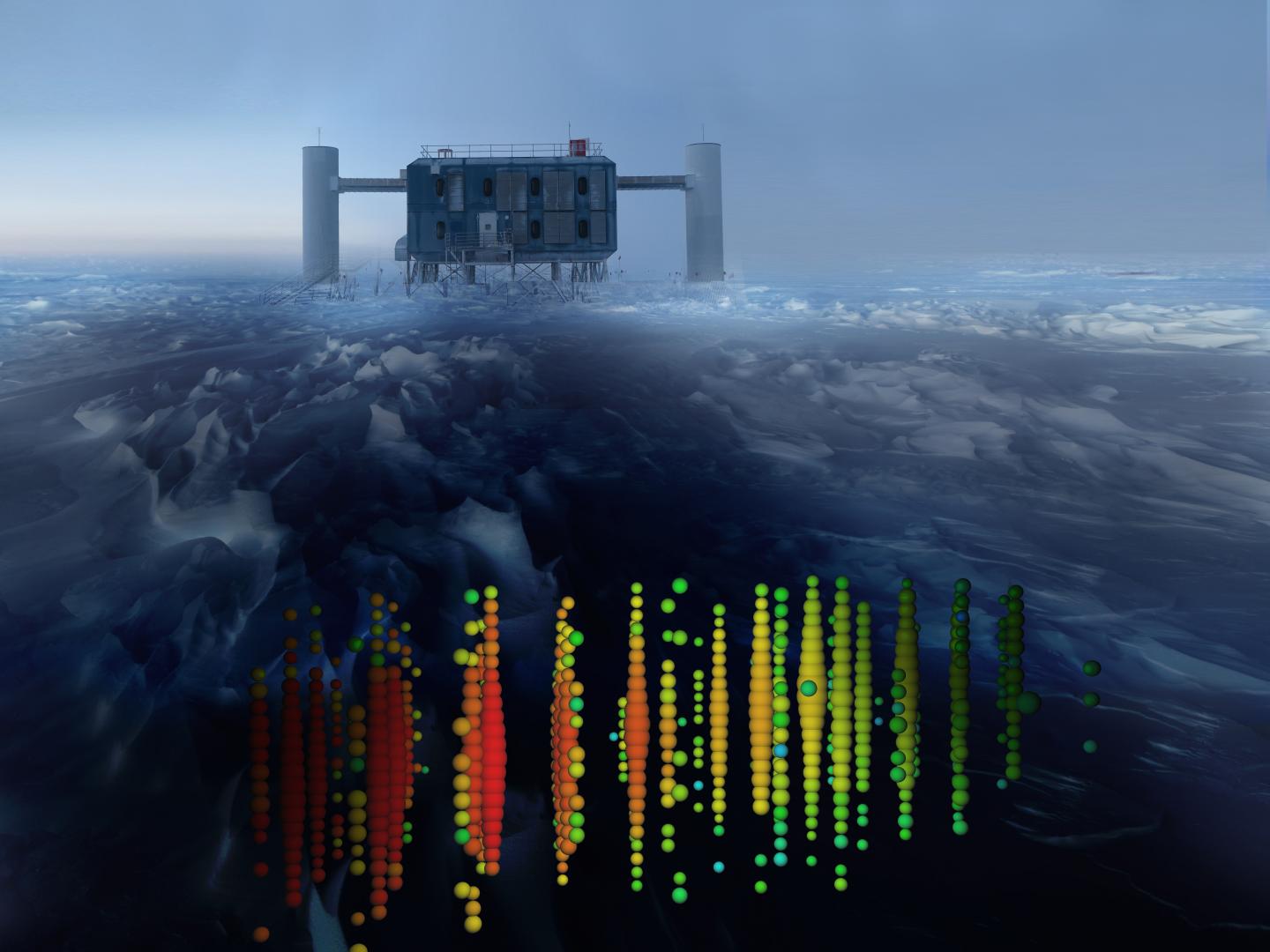
At the Amundsen–Scott South Pole Station in Antarctica lies the IceCube Neutrino Observatory – a facility dedicated to the study of elementary particles known as neutrino. This array consists of 5,160 spherical optical sensors – Digital Optical Modules (DOMs) – buried within a cubic kilometer of clear ice. At present, this observatory is the largest neutrino detector in the world and has spent the past seven years studying how these particles behave and interact.
The most recent study released by the IceCube collaboration, with the assistance of physicists from Pennsylvania State University, has measured the Earth’s ability to block neutrinos for the first time. Consistent with the Standard Model of Particle Physics, they determined that while trillions of neutrinos pass through Earth (and us) on a regular basis, some are occasionally stopped by it.
The study, titled “Measurement of the Multi-TeV Neutrino Interaction Cross-Section with IceCube Using Earth Absorption“, recently appeared in the scientific journal Nature. The study team’s results were based on the observation of 10,784 interactions made by high-energy, upward moving neutrinos, which were recorded over the course of a year at the observatory.
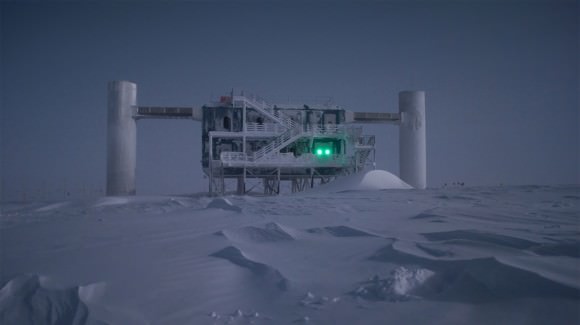
Back in 2013, the first detections of high-energy neutrinos were made by IceCube collaboration. These neutrinos – which were believed to be astrophysical in origin – were in the peta-electron volt range, making them the highest energy neutrinos discovered to date. IceCube searches for signs of these interactions by looking for Cherenkov radiation, which is produced after fast-moving charged particles are slowed down by interacting with normal matter.
By detecting neutrinos that interact with the clear ice, the IceCube instruments were able to estimate the energy and direction of travel of the neutrinos. Despite these detections, however, the mystery remained as to whether or not any kind of matter could stop a neutrino as it journeyed through space. In accordance with the Standard Model of Particle Physics, this is something that should happen on occasion.
After observing interactions at IceCube for a year, the science team found that the neutrinos that had to travel the farthest through Earth were less likely to reach the detector. As Doug Cowen, a professor of physics and astronomy/astrophysics at Penn State, explained in a Penn State press release:
“This achievement is important because it shows, for the first time, that very-high-energy neutrinos can be absorbed by something – in this case, the Earth. We knew that lower-energy neutrinos pass through just about anything, but although we had expected higher-energy neutrinos to be different, no previous experiments had been able to demonstrate convincingly that higher-energy neutrinos could be stopped by anything.”
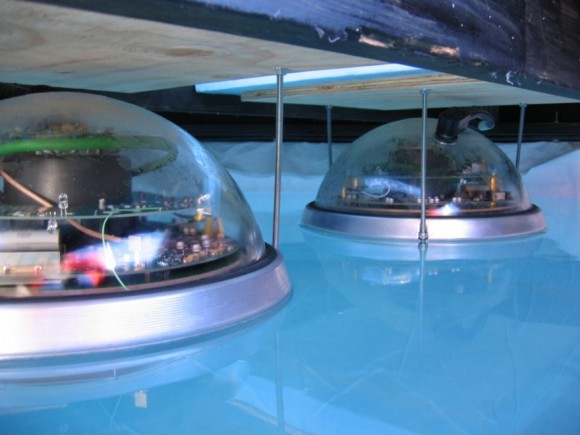
The existence of neutrinos was first proposed in 1930 by theoretical physicist Wolfgang Pauli, who postulated their existence as a way of explaining beta decay in terms of the conservation of energy law. They are so-named because they are electrically neutral, and only interact with matter very weakly – i.e. through the weak subatomic force and gravity. Because of this, neutrinos pass through normal matter on a regular basis.
Whereas neutrinos are produced regularly by stars and nuclear reactors here on Earth, the first neutrinos were formed during the Big Bang. The study of their interaction with normal matter can therefore tell us much about how the Universe evolved over the course of billions of years. Many scientists anticipate that the study of neutrinos will indicate the existence of new physics, ones which go beyond the Standard Model.
Because of this, the science team was somewhat surprised (and perhaps disappointed) with their results. As Francis Halzen – the principal investigator for the IceCube Neutrino Observatory and a professor of physics at the University of Wisconsin-Madison – explained:
“Understanding how neutrinos interact is key to the operation of IceCube. We were of course hoping for some new physics to appear, but we unfortunately find that the Standard Model, as usual, withstands the test.
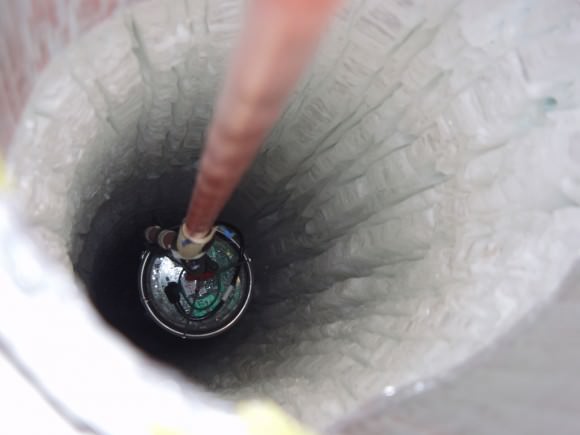
For the most part, the neutrinos selected for this study were more than one million times more energetic than those that are produced by our Sun or nuclear power plants. The analysis also included some that were astrophysical in nature – i.e. produced beyond Earth’s atmosphere – and may have been accelerated towards Earth by supermassive black holes (SMBHs).
Darren Grant, a professor of physics at the University of Alberta, is also the spokesperson for the IceCube Collaboration. As he indicated, this latest interaction study opens doors for future neutrino research. “Neutrinos have quite a well-earned reputation of surprising us with their behavior,” he said. “It is incredibly exciting to see this first measurement and the potential it holds for future precision tests.”
This study not only provided the first measurement of the Earth’s absorption of neutrinos, it also offers opportunities for geophysical researchers who are hoping to use neutrinos to explore Earth’s interior. Given that Earth is capable of stopping some of the billions of high-energy particles that routinely pass through it, scientists could develop a method for studying the Earth’s inner and outer core, placing more accurate constraints on their sizes and densities.
It also shows that the IceCube Observatory is capable of reaching beyond its original purpose, which was particle physics research and the study of neutrinos. As this latest study clearly shows, it is capable of contributing to planetary science research and nuclear physics as well. Physicists also hope to use the full 86-string IceCube array to conduct a multi-year analysis, examining even higher ranges of neutrino energies.
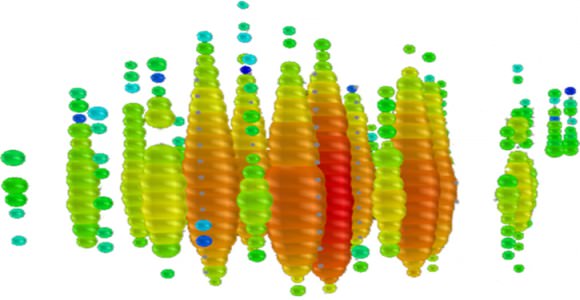
As James Whitmore – the program director in the National Science Foundation’s (NSF) physics division (which provides support for IceCube) – indicated, this could allow them to truly search for physics that go beyond the Standard Model.
“IceCube was built to both explore the frontiers of physics and, in doing so, possibly challenge existing perceptions of the nature of universe. This new finding and others yet to come are in that spirit of scientific discovery.”
Ever since the discovery of the Higgs boson in 2012, physicists have been secure in the knowledge that the long journey to confirm the Standard Model was now complete. Since then, they have set their sets farther, hoping to find new physics that could resolve some of the deeper mysteries of the Universe – i.e. supersymmetry, a Theory of Everything (ToE), etc.
This, as well as studying how physics work at the highest energy levels (similar to those that existed during the Big Bang) is the current preoccupation of physicists. If they are successful, we might just come to understand how this massive thing known as the Universe works.
Further Reading: Penn State, Nature
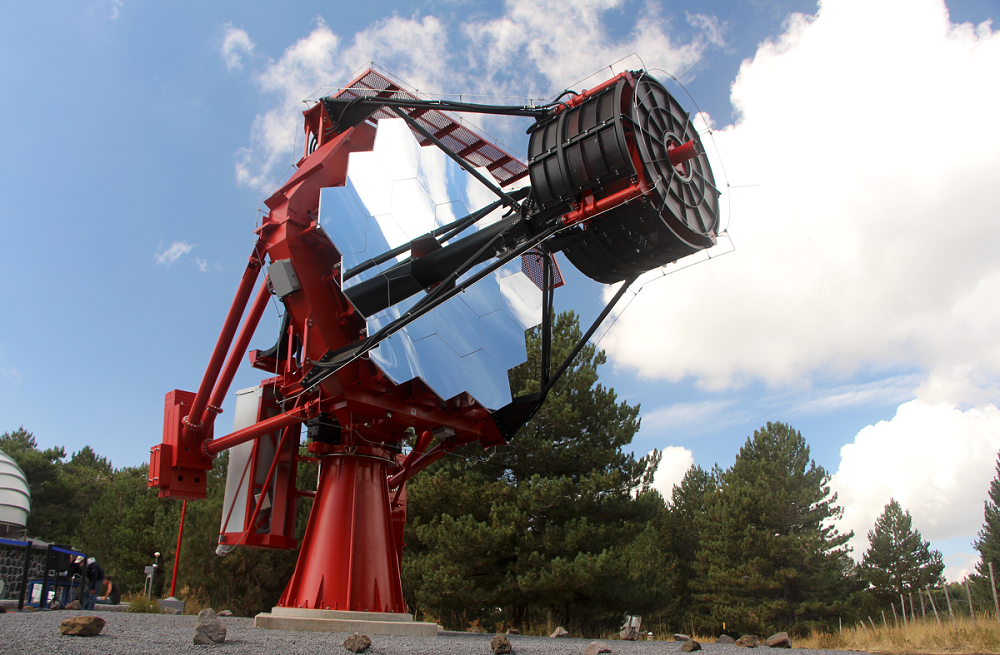
In 2013, the Cherenkov Telescope Array (CTA) was established with the intention of building the world’s largest and most sensitive high-energy gamma ray observatory. Consisting of over 1350 scientists from 210 research institutes in 32 countries, this observatory will use 100 telescopes across the northern and southern hemispheres to explore the high-energy Universe.
Key to their efforts is a prototype dual-mirror Schwarzschild-Couder telescope, known as the Astrofisica con Specchi a Tecnologia Replicante Italiana (ASTRI). Since it was first created in 2014, this prototype has been undergoing tests at the Serra La Nave Observing Station on Mount Etna, Sicily. And as of October of 2016, it passed its most important test to date, demonstrating a constant point-spread function across its full field of view.
The ASTRI telescope is essentially a revolutionary kind of Imaging Atmospheric Cherenkov Telescope (IACT). These ground-based telescopes are used by astronomers to detect cosmic high-energy gamma rays. These rays are produced by the most energetic objects in the universe (i.e. pulsars, supernovae, regions around black holes), and are only detectable because of the Cherenkov Effect, which they undergo once they pass into our atmosphere.
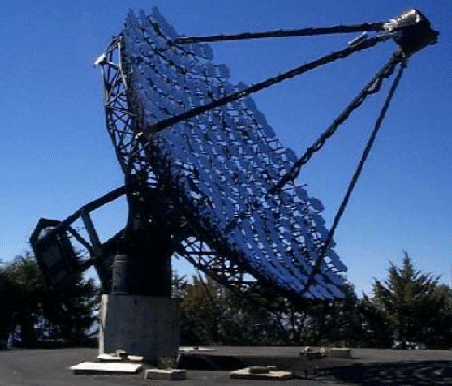
This effect occurs when particles of light achieve speeds greater than the phase velocity of light in their particular medium. In this case, the effect is produced when light particles pass from the vacuum of space into our atmosphere, temporarily exceeding the speed of light in air and producing a glow in the blue to UV range. In the case of very-high-energy gamma rays, indirect observations of this Cherenkov radiation is the only way to detect them.
Typically, Cherenkov telescopes use a mirror to collect light and focus it on a camera. The ASTRI telescope is something quite different, in that it is based on the Schwarzschild-Couder model. As Giovanni Pareschi, an astronomer at the INAF-Brera Astronomical Observatory and the principal investigator of the ASTRI project, told Universe Today via email:
“The ASTRI telescope for the first time is based on a two mirror imaging configuration (while in general Cherenkov telescopes work with in single mirror configuration, i.e. just a big primary mirror with the camera put in the Newtonian focus and a f-number close to 1). ASTRI is a prototype of the telescopes of the Small Size Telescope sub-array of the CTA Observatory. The sub-array is devoted to detect the gamma rays with the highest energy (up to 100 Tev). In order to properly work, the sub-array has to be based on a large number of telescopes (70 units) with a distance from each other of a 250 m distributed and with a large field (10 deg x 10 deg) of view with a constant angular resolution of a few arc minutes across the field of view.
This idea for such a telescope was first proposed in 1905 by German astronomer Karl Schwarzschild, but remained dormant for almost a century since it was deemed too difficult and too expensive to construct. It was not until 2007 that it was considered as a viable means for creating a new type of IACT. And in 2014, the INAF-Brera Astronomical Observatory commissioned the first of its kind to be built.
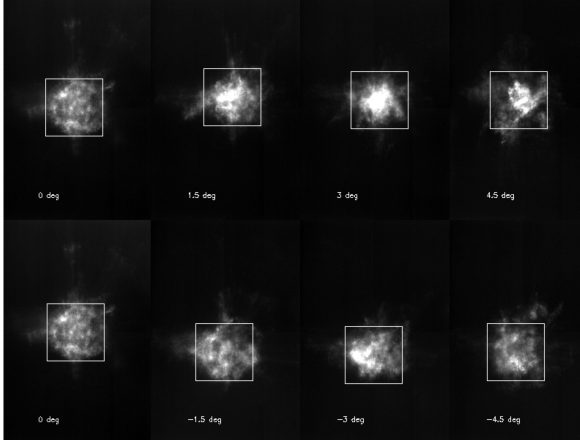
“[W]e have for the first time adopted a two reflection design based on the Schwarzschild-Couder configuration never realized before (also for telescopes operating in the visible band),” added Pareschi. “This configuration allows us to optimize the angular resolution across the field of view and to use focal plane cameras of small dimensions (thanks to this property, we could use new solid-state technology based Silicon photomultiplier sensors instead of the “old” classical photomultiplier tubes used so far in Cherenkov astronomy).”
These advantages, and the advances they allow for, will make ASTRI telescope approximately ten times more sensitive than current instruments. And with this latest test – which demonstrating a constant point-spread function of a few arc minutes over a large field of view of 10 degrees – the team behind it now has proof that it will work. As Pareschi explained:
“The test demonstrated for the first time that a telescope based on the Schwarzschild-Couder configuration correctly works and that a two-mirror configuration can be adopted for making Cherenkov telescopes for gamma ray astronomy. In addition, the ASTRI prototype has been completely characterized and validated from the opto-mechanical point of view, demonstrating that we can now proceed with the construction of the Small-Sized Telescopes (SSTs) of the array based on the ASTRI design.”
With this important test complete, the INAF-Brera team hopes to spend the next few months prepping the telescope. This will include mounting the Cherenkov camera onto the prototype and testing its gamma-ray performance. Then they will start to produce the first set of ASTRI telescopes to create a mini-array, which will serve as a precursor to the planned CTA sub-array that is scheduled to be built in Chile.
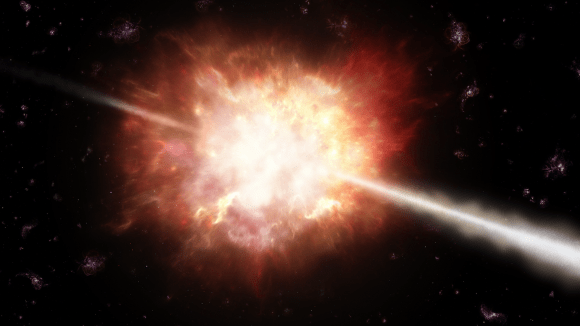
Once the camera is tested and mounted, the ASTRI team will conduct their first observations of gamma-rays at very high energies. These observations will allow scientists to determine the direction of gamma-ray photons that are the result of celestial sources, such as neutron stars, pulsars, supernovae, and black holes, tracing them back to their respective sources.
And with the planned construction of 100 SSTs to be spread out over the northern and southern hemispheres, the CTA array will outnumber all other telescopes in the world. The wide coverage and large number of these telescopes, spread over a wide area, will improve astronomers chances of detecting very high-energy gamma rays as they pass into our atmosphere.
Further Reading: CTA

Under Mount Ikeno, Japan, in an old mine that sits one-thousand meters (3,300 feet) beneath the surface, lies the Super-Kamiokande Observatory (SKO). Since 1996, when it began conducting observations, researchers have been using this facility’s Cherenkov detector to look for signs of proton decay and neutrinos in our galaxy. This is no easy task, since neutrinos are very difficult to detect.
But thanks to a new computer system that will be able to monitor neutrinos in real-time, the researchers at the SKO will be able to research these mysteries particles more closely in the near future. In so doing, they hope to understand how stars form and eventually collapse into black holes, and sneak a peak at how matter was created in the early Universe.
Neutrinos, put simply, are one of the fundamental particles that make up the Universe. Compared to other fundamental particles, they have very little mass, no charge, and only interact with other types of particles via the weak nuclear force and gravity. They are created in a number of ways, most notably through radioactive decay, the nuclear reactions that power a star, and in supernovae.
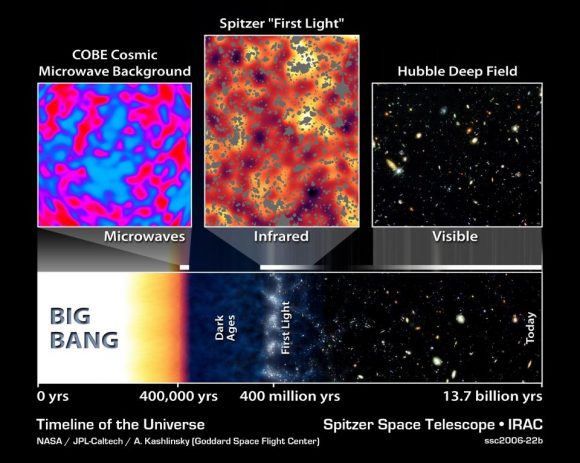
In accordance with the standard Big Bang model, the neutrinos left over from the creation of the Universe are the most abundant particles in existence. At any given moment, trillions of these particles are believed to be moving around us and through us. But because of the way they interact with matter (i.e. only weakly) they are extremely difficult to detect.
For this reason, neutrino observatories are built deep underground to avoid interference from cosmic rays. They also rely on Cherenkov detectors, which are essentially massive water tanks that have thousands of sensors lining their walls. These attempt to detect particles as they are slowed down to the local speed of light (i.e. the speed of light in water), which is made evident by the presence of a glow – known as Cherenkov radiation.
The detector at the SKO is currently the largest in the world. It consists of a cylindrical stainless steel tank that is 41.4 m (136 ft) tall and 39.3 m (129 ft) in diameter, and holds over 45,000 metric tons (50,000 US tons) of ultra-pure water. In the interior, 11,146 photomultiplier tubes are mounted, which detect light in the ultraviolet, visible, and near-infrared ranges of the electromagnetic spectrum with extreme sensitivity.
For years, researchers at the SKO have used the facility to examine solar neutrinos, atmospheric neutrinos and man-made neutrinos. However, those that are created by supernovas are very difficult to detect, since they appear suddenly and difficult to distinguish from other kinds. However, with the newly-added computer system, the Super Komiokande researchers are hoping that will change.
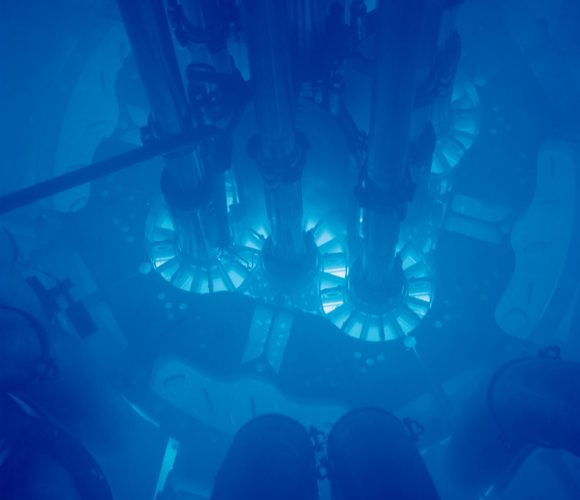
As Luis Labarga, a physicist at the Autonomous University of Madrid (Spain) and a member of the collaboration, explained in a recent statement to the Scientific News Service (SINC):
“Supernova explosions are one of the most energetic phenomena in the universe and most of this energy is released in the form of neutrinos. This is why detecting and analyzing neutrinos emitted in these cases, other than those from the Sun or other sources, is very important for understanding the mechanisms in the formation of neutron stars –a type of stellar remnant– and black holes”.
Basically, the new computer system is designed to analyze the events recorded in the depths of the observatory in real-time. If it detects an abnormally large flows of neutrinos, it will quickly alert the experts manning the controls. They will then be able to assess the significance of the signal within minutes and see if it is actually coming from a nearby supernova.
“During supernova explosions an enormous number of neutrinos is generated in an extremely small space of time – a few seconds – and this why we need to be ready,” Labarga added. “This allows us to research the fundamental properties of these fascinating particles, such as their interactions, their hierarchy and the absolute value of their mass, their half-life, and surely other properties that we still cannot even imagine.”
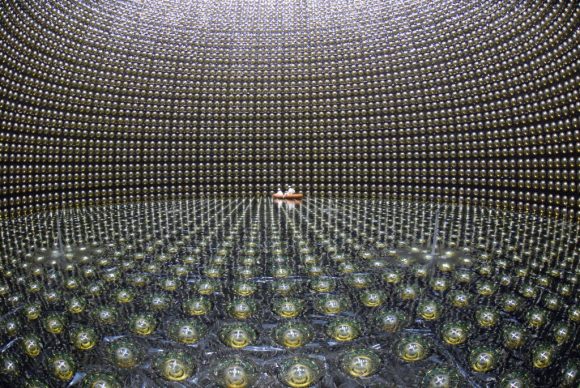
Equally as important is the fact this system will give the SKO the ability to issue early warnings to research centers around the world. Ground-based observatories, where astronomers are keen to watch the creation of cosmic neutrinos by supernova, will then be able to point all of their optical instruments towards the source in advance (since the electromagnetic signal will take longer to arrive).
Through this collaborative effort, astrophysicists may be able to better understand some of the most elusive neutrinos of all. Discerning how these fundamental particles interact with others could bring us one step closer to a Grand Unified Theory – one of the major goals of the Super-Kamiokande Observatory.
To date, only a few neutrino detectors exist in the world. These include the Irvine-Michigan-Brookhaven (IMB) detector in Ohio, the Subdury Neutrino Observatory (SNOLAB) in Ontario, Canada, and the Super Kamiokande Observatory in Japan.
Further Reading: SINC
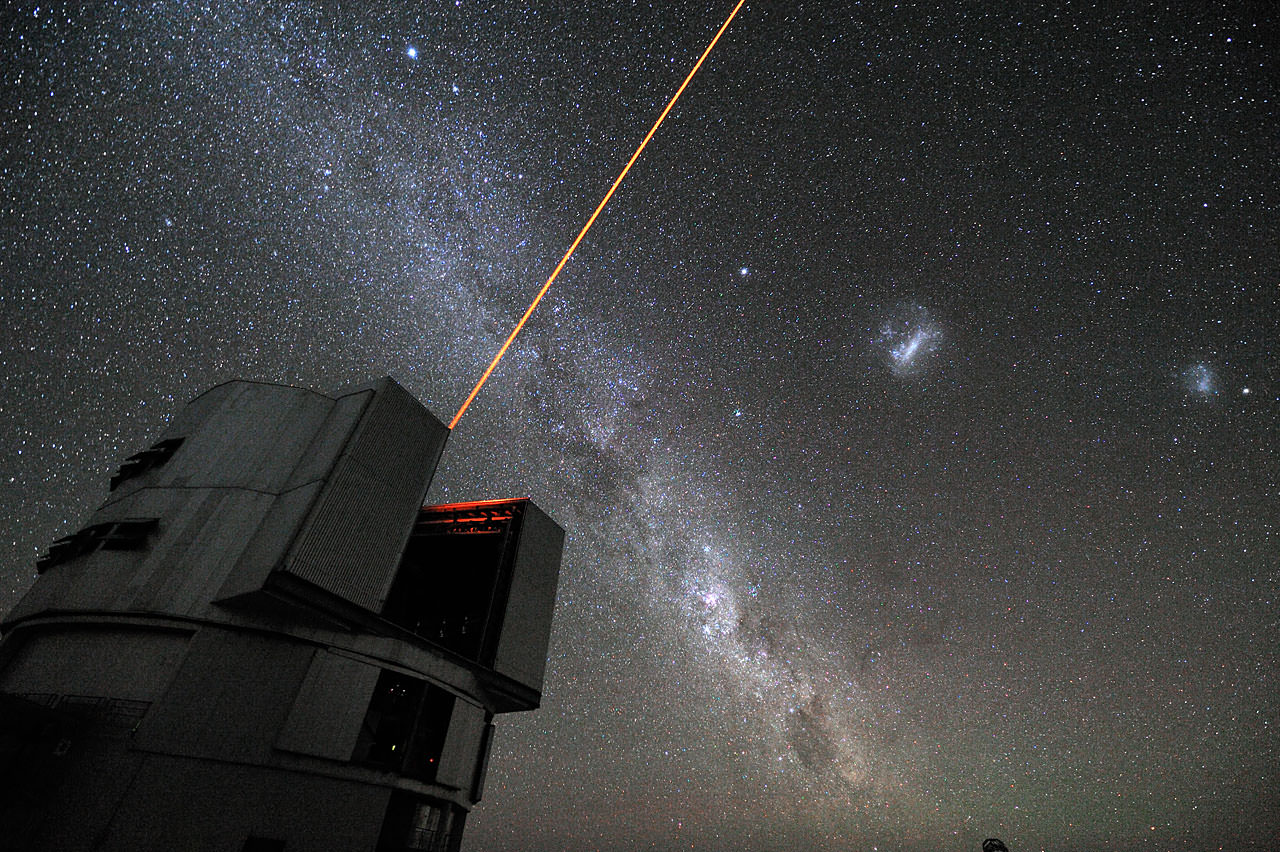
It’s a cornerstone of modern physics that nothing in the Universe is faster than the speed of light (c). However, Einstein’s theory of special relativity does allow for instances where certain influences appear to travel faster than light without violating causality. These are what is known as “photonic booms,” a concept similar to a sonic boom, where spots of light are made to move faster than c.
And according to a new study by Robert Nemiroff, a physics professor at Michigan Technological University (and co-creator of Astronomy Picture of the Day), this phenomena may help shine a light (no pun!) on the cosmos, helping us to map it with greater efficiency.
Consider the following scenario: if a laser is swept across a distant object – in this case, the Moon – the spot of laser light will move across the object at a speed greater than c. Basically, the collection of photons are accelerated past the speed of light as the spot traverses both the surface and depth of the object.
The resulting “photonic boom” occurs in the form of a flash, which is seen by the observer when the speed of the light drops from superluminal to below the speed of light. It is made possible by the fact that the spots contain no mass, thereby not violating the fundamental laws of Special Relativity.
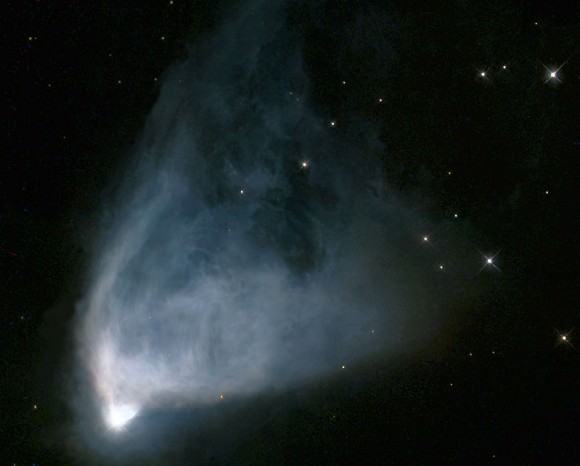
Another example occurs regularly in nature, where beams of light from a pulsar sweep across clouds of space-borne dust, creating a spherical shell of light and radiation that expands faster than c when it intersects a surface. Much the same is true of fast-moving shadows, where the speed can be much faster and not restricted to the speed of light if the surface is angular.
At a meeting of the American Astronomical Society in Seattle, Washington earlier this month, Nemiroff shared how these effects could be used to study the universe.
“Photonic booms happen around us quite frequently,” said Nemiroff in a press release, “but they are always too brief to notice. Out in the cosmos they last long enough to notice — but nobody has thought to look for them!”
Superluminal sweeps, he claims, could be used to reveal information on the 3-dimensional geometry and distance of stellar bodies like nearby planets, passing asteroids, and distant objects illuminated by pulsars. The key is finding ways to generate them or observe them accurately.
For the purposes of his study, Nemiroff considered two example scenarios. The first involved a beam being swept across a scattering spherical object – i.e. spots of light moving across the Moon and pulsar companions. In the second, the beam is swept across a “scattering planar wall or linear filament” – in this case, Hubble’s Variable Nebula.
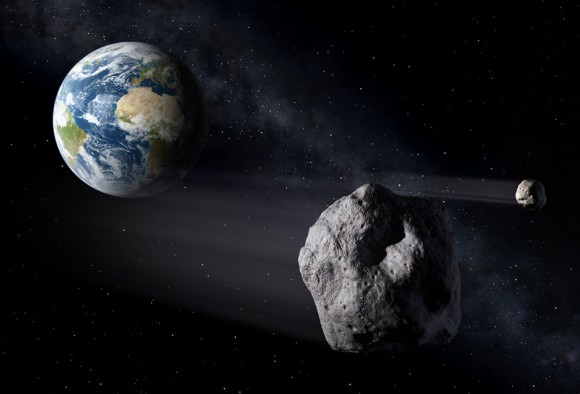
In the former case, asteroids could be mapped out in detail using a laser beam and a telescope equipped with a high-speed camera. The laser could be swept across the surface thousands of times a second and the flashes recorded. In the latter, shadows are observed passing between the bright star R Monocerotis and reflecting dust, at speeds so great that they create photonic booms that are visible for days or weeks.
This sort of imaging technique is fundamentally different from direct observations (which relies on lens photography), radar, and conventional lidar. It is also distinct from Cherenkov radiation – electromagnetic radiation emitted when charged particles pass through a medium at a speed greater than the speed of light in that medium. A case in point is the blue glow emitted by an underwater nuclear reactor.
Combined with the other approaches, it could allow scientists to gain a more complete picture of objects in our Solar System, and even distant cosmological bodies.
Nemiroff’s study accepted for publication by the Publications of the Astronomical Society of Australia, with a preliminary version available online at arXiv Astrophysics
Further reading:
Michigan Tech press release
Robert Nemiroff/Michigan Tech